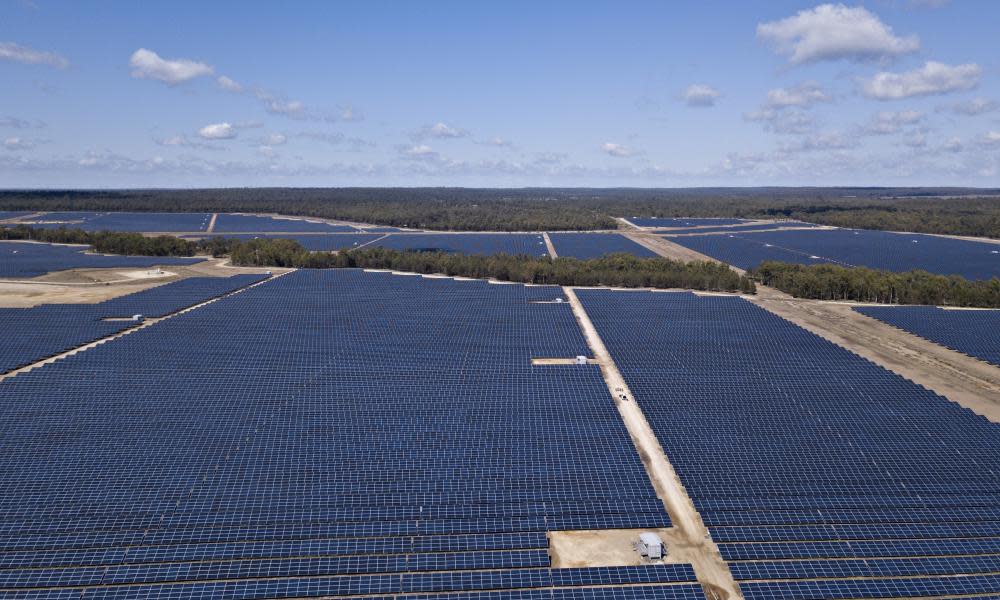NSW government says renewable energy zone in New England could power 3.5m homes

The New South Wales government aims to back renewable energy plants in the New England region with the capacity to power 3.5m homes, with the state’s environment minister saying enough will be built to replace most of the state’s coal-fired power stations earlier than scheduled.
Matt Kean, the minister for energy and the environment, will on Friday announce a second renewable energy zone for the state, following a previously planned designated area in the state’s central west.
He said the latest announcement – that the government would look to attract investors to build 8,000 megawatts of wind and solar in the New England region in the state’s north – was effectively “a huge, modern-day power station”.
“This is a huge stimulus package. It’s good for the economy, it’s good for the environment and – guess what – we have to replace our existing generators anyway,” Kean told Guardian Australia.
“By bringing that forward there are enormous economic benefits, enormous benefits for families because it will help lower electricity prices, and enormous benefits for the environment because it’s clean electricity.”
The new renewable energy zone is more than double the size of the first zone announced in the state’s central west, which attracted interest from renewable energy investors with a combined capacity of 27 gigawatts and valued at $38bn – nine times the available capacity.
Kean said the new zone would put the state on course for decarbonisation. The government has joined other states in setting a target for the state to reach net zero emissions by 2050 – consistent with what scientists say is necessary, but at odds with the Morrison government, which has resisted calls to adopt the goal.
The government will promise $79m to be spent on planning and coordination of projects, transmission and storage. It said that was expected to generate $12.7bn in investment that would create 2,000 jobs in the construction phase and 1,300 ongoing positions.
Kean said much of it would be in regional communities that were feeling the economic effects of the Covid-19 pandemic.
“The capacity we’re building in this renewable energy zone is enough to replace the majority of our remaining coal-fired power stations,” he said.
“We know that our existing sources of electricity, existing generators, are coming to the end of their useful lives. The beauty of this project is it will have a huge stimulus impact on the economy ... Better still, it’s clean energy going into the system.”
Reserve Bank research found commitments on new large-scale renewable energy projects fell about 50% last year after the national renewable energy target was filled and not replaced. It followed record levels of investment in 2017 and 2018.
Related: AGL says it will link bosses’ bonuses to lowering emissions
Investment in rooftop solar panels has continued to increase. Green Energy Markets, a consultancy and research firm, found Australia added a record 1,357MW of new rooftop solar photovoltaics in the first half of 2020, 40% higher than the same period in 2019. But spending on large-scale plants has increasingly been driven by state government policy.
Kean said “what would be ideal is that we’d have a national approach to this”. But he said state governments had demonstrated they could design energy policy that met a state’s specific needs.
For NSW, he said that was not about renewables alone, but building transmission and storage into the system before old facilities expired. The federal government last year also committed $1bn to the Clean Energy Finance Corporation for transmission upgrades and energy storage projects.
The NSW government also recently released a statement on coal exploration and mining that said the industry would generate regional jobs and royalties for decades to come, and supported the approval of Santos’ controversial $3.6bn Narrabri coal-seam gas development.
But Kean said he was confident the state would surpass its target of a 35% cut in greenhouse gas emissions compared with 2005 levels by 2030, and could build a competitive advantage in a global, low-carbon economy.
“Come 2030, when we will be living in a low-carbon economy, we will be well placed to be an energy and economic superpower,” he said.

 Yahoo News
Yahoo News 
